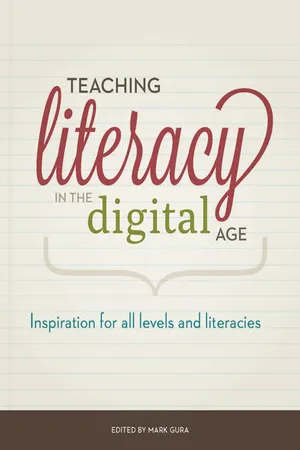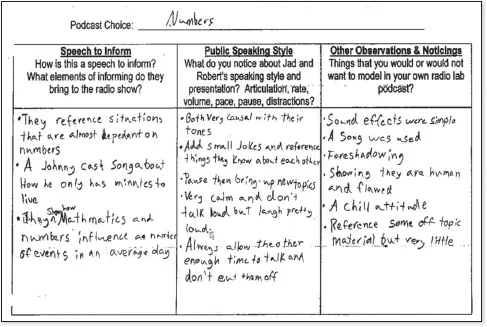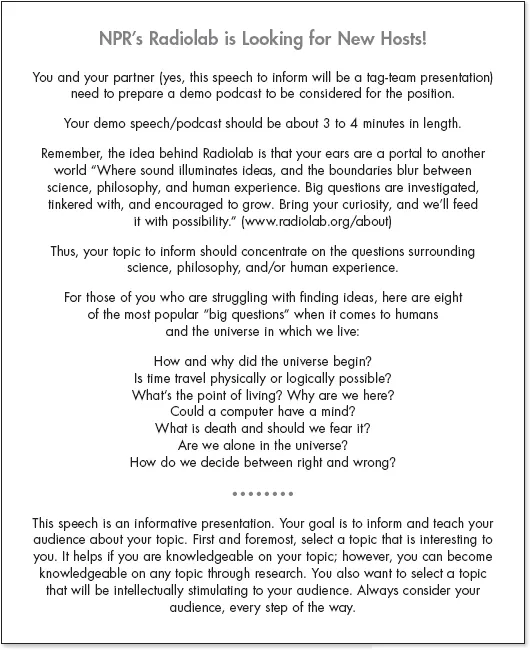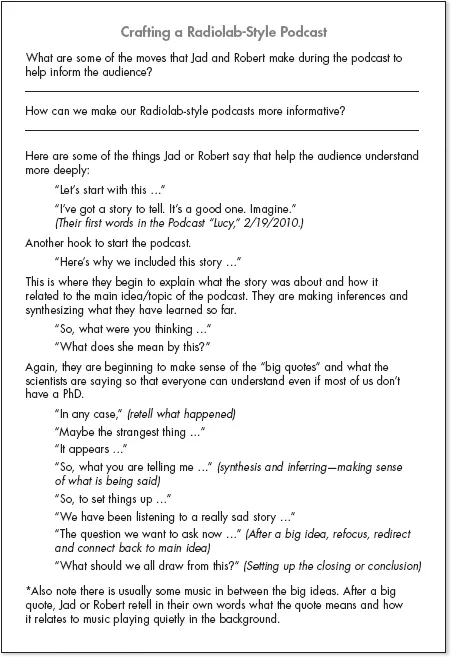![]()
SECTION IV
PERSUASIVE AND
argumentative
WRITING
CHAPTER 11
Building Literacy Radiolab-Style: Podcasting to Foster Speech and Debate Skills
Grades 6–8 / Ages 11–14 / Middle School
Radiolab podcast archive, Audacity, Sound Jay, Naturesongs
CHAPTER 12
Crafting an Argumentative Essay with Evernote
Grades 6–12 / Ages 11–18 / Middle and High School
Evernote
CHAPTER 13
Enhancing the Argument: Using Threaded Discussion as a Persuasive Prewriting Tool
Grade 8 / Ages 13–14 / Middle School
Edublogs
CHAPTER 14
Building Literacy with Popular Web 2.0 Tools
Grades K–12 / Ages 5–18 / Elementary, Middle, and High School
Blogging, Edmodo, Wordle, Audacity
![]()
CHAPTER 11
Building Literacy Radiolab-Style
Podcasting to Foster Speech and Debate Skills
Michele L. Haiken
LEVEL
Grades 6–8 / Ages 11–14 / Middle School
TECHNOLOGIES
Radiolab podcast archive, Audacity, Sound Jay, Naturesongs.com
LITERACY
Speech and debate, informative writing, persuasive writing
STANDARDS
ISTE Standards•S, Common Core ELA (Anchor Standards)
Looking for a new way to teach informative writing and public speaking, I was inspired by one of my favorite shows on National Public Radio. Radiolab hosts Jad Abumrad and Robert Krulwich combine reporting and documentary in fast-moving discussions about topics ranging from science and philosophy to human experience. Most of the topics are science related, but even I—an English teacher—am interested and engaged because of the way the hosts present the material.
The more I listened to various Radiolab podcasts, the more I realized each episode was actually a speech to inform about a specific scientific inquiry. The sound bites, music, and engaging discussions made me want to listen. I asked myself, “Why not have students create their own Radiolab-style podcasts about topics that are of interest to them?” I decided that we could post their podcasts on the school’s website to share them with the school community and reach out to a wider audience.
Background of Practice
At my school, Speech and Debate is an academic elective for seventh and eighth grade students. The course is designed to cover the elements of informative and persuasive speech and writing. Speech and Debate might also be taught in the upper elementary grades as well as high school; teachers would need to modify these assignments depending on their students’ skills and abilities. In fact, this assignment can be adapted for any secondary content area classroom. For Grades 9–12, modifications can be made to the podcasting topics, and different Radiolab examples can be shared with students at the beginning of the unit.
In my middle school, Speech and Debate class students spend the first ten weeks of the semester focusing on vocal expression and informative and persuasive speaking; the last ten weeks of the semester cover the elements of debate.
An informative speech is the first speech students write and present to the class. I wanted to have my students write a speech that involved real-world writing and addressed topics that were of interest to them. (I needed a change from the “Invent Your Own Candy” and “Great Vacation Travel Agency School” speeches students had written in the past!) I had recorded student speeches and debates in previous classes, but those were for students to listen to in order to glean tips on speaking. With the Radiolab-style podcasts, students knew that they were writing and speaking for recording purposes, with the ultimate goal of sharing their recordings with an online audience.
The objective with the Radiolab assignment was for students to create a podcast that was informative and intellectually stimulating. The unit took four weeks from the introduction of informative speaking, to studying the craft of a Radiolab podcast, to conducting research and writing scripts, and finally to the presentation of projects. Students met every day for this project and all the work was done in the classroom.
Setting Things Up
Radiolab can be seen as nonfiction text that extends across genres; as such, it was used as a model for students’ writing and public speaking projects.
Hardware and Setup Resources
Here are the suggested hardware and setup resources for creating a Radiolab-style podcast:
Equipment
Computer (Mac or PC): desktop or laptop
Microphone: to record podcasts
Resources
Audacity: http://audacity.sourceforge.net
Free software program for recording and editing
Sound Jay: www.soundjay.com
Free sound effects to download
Naturesongs.com: www.naturesongs.com
Lots of free nature sounds
Radiolab Archives: www.radiolab.org/archive
Radiolab archive of podcast episodes
First Two Days
First, in the computer lab, students listened to two different Radiolab podcasts, and each student completed a graphic organizer/analysis worksheet to help direct their listening. Students worked independently and used headphones to listen to the podcasts individually. All work was done during class time. A teacher could adapt this part of the project by assigning the listening and reaction piece for homework or as a whole-class listening task.
During the first two days of the unit, students were to listen to one of two podcasts I had selected and complete an analysis worksheet (Figure 11.1). Next, they listened to a podcast of their own choice from the archives available on the Radiolab website.
Figure 11.1 Student Radiolab analysis worksheet
Analyzing and Preparing
After listening, students discussed their observations and dissected the organizational structure of the podcast. In small groups, they responded to these questions:
1. In what way is this a speech to inform?
2. How effectively did the speech opening capture and hold your attention?
3. How did the speakers encourage the audience to learn?
4. What did the speakers do effectively to convey new information to the audience?
5. What were the speakers’ strongest assets in informing the audience?
Introducing the Assignment
After analysis on the style and craft of the Radiolab podcasts, students were introduced to the assignment (Figure 11.2).
Many students selected topics from the suggested list—in particular, the question about whether we are alone in the universe. Other students came up with their own topics (for example: “Who is a stronger superhero, Batman or Superman?”). I gave each pair of students an outline to help them begin drafting their podcast manuscript (Form 11.1). Students followed the writing process of editing and revising using pen and paper or keyboarding their outline on the computer.
Students spent the first two days in the computer lab doing research and gathering support material to answer questions and learn more about their topics. Students gathered relevant information from multiple digital sources and integrated it into their podcasts. The elements of an informative speech were already discussed in earlier lessons. The outline reinforced the layout and style their podcasts should follow.
It was important to remind students that their speeches would be heard and not read, so students needed to understand the difference between writing an informative essay and crafting an informative podcast. We took a break during the drafting stage to examine the “moves” the Radiolab hosts made to keep listeners engaged and informed.
Students returned to their original graphic organizer/analysis worksheet for words or phrases that caught their attention during the podcast. I also catalogued and shared a handout with some of the phrases that caught my attention while listening to a variety of Radiolab podcasts (Form 11.2). Students were then able to model the transitions made by the Radiolab hosts and insert them into their own podcast manuscripts.
Figure 11.2 Radiolab “Speech to Inform” assignment/invitation
Form 11.1 Radiolab-style podcast outline handout
Form 11.2 The craft of Radiolab handout
Writing, Recording, and Editing
Students drafted their podcasts with their Radiolab podcast partners in the computer lab. Students worked side-by-side with their partners when compiling research and shared computers when they were producing their podcast manuscripts. This allowed me to circulate and offer individual support. I read over student podcast manuscripts, made edits, and asked questions in order to help students clarify wording. This time was also used to help students find sound effects (we used Sound Jay) to add to their podcasts that would help convey meaning and offer additional engagement for the listener.
Students had a day to practice the conversational style of speaking they heard on the original Radiolab podcasts. On the day of the recording, our school technology specialist helped record the podcasts. While we were recording each group’s podcast, other groups were rehearsing and compiling sound effects.
Many of the podcasts were recorded “as is.” Students were able to re-record when they didn’t like their opening statements or if they messed up a few lines; long pauses were eliminated and sound effects were added later. Once students watched the technology specialist and I use Audacity, they quickly got the hang of it and were able to edit their own podcasts.
Assessment and Standards Addressed
Assessment
Student podcasts were evaluated based on content, presentation, and collaboration of the partners on the podcast. This assignment was done completely during class time, although students could choose to work on it after school, as well. We created an evaluation rubric and included “Use of class time” in the rubric.
The podcasts were uploaded onto our class wiki as well as the school website. Students and parents were invited to listen to the engaging and informative audio content that our students had created.
Standards Addressed
ISTE Standards for Students (ISTE Standards•S)
Students used multiple literacies throughout the project, which allowed them to “demonstrate creative thinking and develop innovative products and processes using technology” (ISTE Standards•S, Creativity and Innovation). Students used “digital media and environments to communicate and work collaboratively” (ISTE Standards•S, Communication and Collaboration). Students used a variety of digital sources on the internet “to gather, evaluate, and use information” for their podcasts (ISTE Standards•S, Research and Information Fluency). Students used “critical-thinking skills to plan” and write and manage their podcast manuscripts (ISTE Standards•S, Critical Thinking, Problem Solving, and Decision Making). Students were acting as digital citizens contributing in a positive way (ISTE Standards•S, Digital Citizenship) to create unique podcasts that would be shared with a wider audience outside of our classroom walls. Lastly, students demonstrated “a sound understanding of technology concepts, systems, and operations” involved in ...




